While I researched By George, I came across the escape route used by John Wilkes Booth in the immediate aftermath of the Abraham Lincoln assassination. Every student in the United States likely learned all about the assassination multiple times starting from elementary school and every year thereafter. Fewer probably knew much about the attempted escape.
I confess to understanding no more than a few basic details of Booth’s brief flight from justice. Then I started to wonder if I could find the exact spot where Booth died, a rather macabre subject for sure, although certainly a legitimate topic for a geo-oddity blog.
John Wilkes Booth’s Foiled Escape

For example, I knew all about Ford’s Theater where Booth shot Lincoln. It’s still there, an active home to the performing arts, and I’ve been to it a bunch of times. I’d never heard of Richard H. Garrett’s farm, though. That’s where Booth died.
Flight
John Wilkes Booth fled south from the city into Maryland after he committed his horrendous crime. He stopped at Surratt’s Tavern for guns and supplies he’d stashed there earlier. Then he traveled to to the home of Dr. Samuel Mudd who set his broken leg. Mudd later went to prison for four years at remote Fort Jefferson in the Dry Tortugas for doing that (I saw his jail cell!).
Booth then stayed with various Confederate sympathizers, hid in the woods, and crossed the Potomac River into Virginia. Eventually he found his way to Garrett’s farm. Garrett apparently had no idea who he was dealing with. In fact hadn’t even heard about Lincoln’s assassination. The final months of the war decimated lines of communication in Virginia and the news hadn’t arrived yet.
Trapped
Union soldiers tracked Booth down to the farm and cornered him in a tobacco barn on Garrett’s property. Booth refused to surrender so they set the barn on fire. One of the soldiers shot Booth — some say in cold blood — and they carried Booth to Garrett’s front porch where he died several hours later. That would seem to be a rather historic spot yet it no longer exists. The house fell into disrepair in spite of its notoriety and eventually collapsed upon itself.
“The place where Booth died is as unsung as modernity can make it, a forgotten median, sandwiched between the north and southbound lanes of a divided, four-lane highway. Commuters and truckers speed by, wholly unaware that they’ve passed the location where the most famous manhunt in United States history came to a violent end.”
The road that passed by Garrett’s home eventually became U.S. Route 301. It later expanded to four lanes (map) and obliterated the few remaining bits of the farm.
Fort A.P. Hill

That wasn’t the only indignity. The United States Army began to expand rapidly in the years leading up to World War II. It searched around the country for out-of-the-way spaces suitable for stashing military functions away from prying eyes. Eastern Virginia looked particularly good, a quite rural hideaway just steps from the nation’s capital, with sixty thousand acres available for the government to seize.
The old Garrett farm fell within the original northern boundary of Fort A.P. Hill. Who exactly was A.P. Hill? He was a Confederate general who fought the Union armies of Abraham Lincoln and died in combat during the Third Battle of Petersburg. It seemed a little ironic that the US Army named a fort for someone who fought against it. Similarly, it seemed strange that the place where Lincoln’s assassin died happened on land that would later be named for a Confederate officer. Yet there it was, and all but forgotten.

Leave a Reply